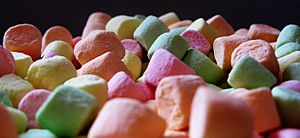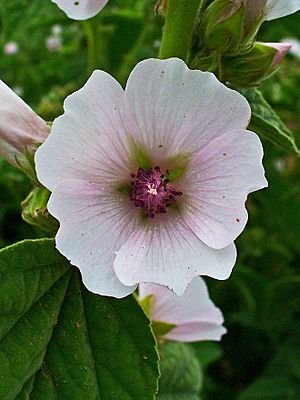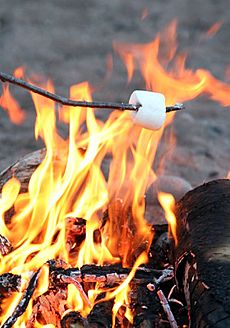Marshmallow facts for kids
A marshmallow is a soft, sweet candy. It's usually made from sugar or corn syrup, water, and gelatin. These ingredients are whipped together until they become light and spongy. Marshmallows are enjoyed on their own, in other sweets, and even in drinks like hot chocolate.
Contents
History of Marshmallows
Marshmallows may have started as a medicine. The original marshmallow plant, called Althaea officinalis, has a root that produces a gooey substance. This substance was used to help with sore throats. People in ancient Egypt used the root in a sweet treat with honey to soothe throats.
Later, in France, a version called pâte de guimauve was made. It included egg white and was often flavored with rose water.
The idea of making sweets from marshmallows goes back to ancient Egypt. People would take sap from the plant and mix it with nuts and honey. Another old recipe used the soft inside part of the marshmallow plant's stem. This part was boiled in sugar syrup and dried to make a soft, chewy candy.
How Modern Marshmallows Developed
In the early 1800s, candy makers in France found a new way to make marshmallows. They whipped the plant's sap and sweetened it. This made a candy similar to what we eat today. However, making it was a lot of work. Small sweet shops had to extract the sap and whip it by hand.
Later in the 1800s, French manufacturers found a trick. They started using egg whites or gelatin mixed with corn starch. This made the chewy base without needing to extract sap from the plant. But it required special factory methods to mix the gelatin and corn starch correctly.
A big step forward happened in 1954 with the "extrusion" process. A Greek American candy maker named Alex Doumakes invented it. This process pushes the marshmallow mixture through special holes. This creates long, continuous "ropes" of marshmallow. This invention made it possible to make marshmallows automatically. It also gave them their familiar round shape.
Today, marshmallows are made in large factories. Water, sugar, and corn syrup are heated in huge kettles. Then, rehydrated gelatin is added once the mixture cools down. To make marshmallows fluffy, air is pumped into the mixture as it's blended. The mixture is then cooled further and pushed through the extrusion heads. It lands on a conveyor belt covered in corn starch. A large knife cuts the long ropes into individual marshmallows. Finally, the pieces are tumbled in more corn starch. This helps them form their outer "skin" and separate.
Marshmallows, like most candies, are sweetened with sugar. They get their light, airy texture from air mixed into the sugar and protein blend. The proteins, like gelatin, help keep the air bubbles from collapsing.
Toasted Marshmallows
A fun tradition in many places is toasting marshmallows over a campfire or other open flame. You put a marshmallow on a stick or skewer. Then, you hold it carefully over the fire. This makes the outside turn golden and slightly crispy. The inside becomes warm and gooey. This browning process is called caramelization. It creates new flavors and colors.
People like their marshmallows toasted in different ways. Some prefer them lightly golden. Others like them with a charred, black outer layer. Sometimes, people even light the marshmallow on fire for a quick char! You can eat the whole toasted marshmallow. Or, you can peel off the crispy outer layer and toast the rest again.
A popular treat made with toasted marshmallows is a S'more. To make a s'more, you place a toasted marshmallow on a piece of chocolate. This is then put between two graham crackers. You squeeze them together, and the warm marshmallow helps the chocolate start to melt.
Images for kids
See also
 In Spanish: Malvavisco para niños
In Spanish: Malvavisco para niños








